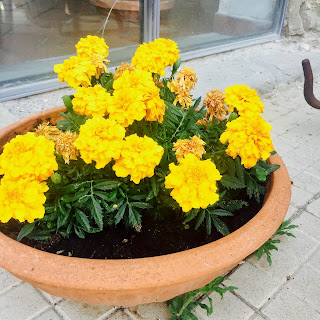After visiting the Pope’s garden in
Castel Gandolfo I seem to have a new view on the different styles of gardens
that there are. The garden that we visited features three main styles
throughout as well as an incorporated 25 hectares of farmland. The Villa
Pontificia features English, French and Italian characteristics. The designs of
these styles help to set the mood of the garden and guide your eye to either
the main feature or through the picture that the plants are creating.
 The
entrance of the garden started as Italian, it was filled with strategically
placed Italian cypress, stone pines, blue Atlas cedar, hydrangeas, ponds and
fountains. The trees, hydrangeas, and the pathways accent the water features
and help to tie everything together. In the Italian garden there are also ruins
from Ancient Rome when the Emperor Domitian (81-96 A.D.) resided in this area.
While these ruins are well preserved there is also an obvious acceptance of the
natural plant life that grows amongst it. The tree roots that are emerging from
the stones are allowed and accepted as part of the ruins; they are not cut away
and hidden, instead it shows that what was once built by man is being overcome
by nature.
The
entrance of the garden started as Italian, it was filled with strategically
placed Italian cypress, stone pines, blue Atlas cedar, hydrangeas, ponds and
fountains. The trees, hydrangeas, and the pathways accent the water features
and help to tie everything together. In the Italian garden there are also ruins
from Ancient Rome when the Emperor Domitian (81-96 A.D.) resided in this area.
While these ruins are well preserved there is also an obvious acceptance of the
natural plant life that grows amongst it. The tree roots that are emerging from
the stones are allowed and accepted as part of the ruins; they are not cut away
and hidden, instead it shows that what was once built by man is being overcome
by nature.
In
the English garden there was less structure. While the trees and the plant life
that was growing looked to be a naturally wooded area it was planted with
purpose. This part of the garden seemed to have brought me back to my roots; I
understood how the Pope enjoyed this area. In my hometown I am comforted by the
cedar and pecan trees that crowd my yard and the live oak that supports the
tree swing my dad hung. This part of the garden reminded me of home because of
the simplicity that it delivered.
The
French garden was my favorite. The garden was covered with boxwood, hedges,
cypress trees, wax begonias, and many other attention seeking shrubs and
flowers. These plants are pruned and maintained in these extravagant and
elegant patterns that seems so perfect that it must be attended to daily. This
garden style is my favorite because of the extensive design and care that is
required to create and maintain a garden of this magnitude. The shrubs must be
in pristine condition in order to continue the flow and deliberation that is being
portrayed in this form of artwork. The Pope’s garden demonstrates that even
though this piece does not involve paper and paint or ink, that designing a
garden is still a form of artwork.
-Erika Johnson



























